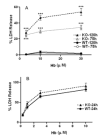Effect of heme oxygenase-1 on the vulnerability of astrocytes and neurons to hemoglobin
- PMID: 16999934
- PMCID: PMC1636847
- DOI: 10.1016/j.bbrc.2006.09.036
Effect of heme oxygenase-1 on the vulnerability of astrocytes and neurons to hemoglobin
Abstract
The heme oxygenase (HO) enzymes catalyze the rate-limiting step of heme breakdown. Prior studies have demonstrated that the vulnerability of neurons and astrocytes to hemoglobin is modified in cells lacking HO-2, the constitutive isoform. The present study assessed the effect of the inducible isoform, HO-1. Wild-type astrocytes treated for 3-5 days with 3-30 microM hemoglobin sustained no loss of viability, as quantified by LDH and MTT assays. The same treatment resulted in death of 25-50% of HO-1 knockout astrocytes, and a 4-fold increase in protein oxidation. Cell injury was attenuated by transfer of the HO-1 gene, but not by bilirubin, the antioxidant heme breakdown product. Conversely, neuronal protein oxidation and cell death after hemoglobin exposure were similar in wild-type and HO-1 knockout cultures. These results suggest that HO-1 induction protects astrocytes from the oxidative toxicity of Hb, but has no effect on neuronal injury.
Figures



References
-
- Hua Y, Xi G, Keep RF, Hoff JT. Complement activation in the brain after experimental intracerebral hemorrhage. J Neurosurg. 2000;92:1016–1022. - PubMed
-
- Hoff JT, Xi G. Brain edema from intracerebral hemorrhage. Acta Neurochir Suppl. 2003;86:11–5. - PubMed
-
- Matz P, Turner C, Weinstein PR, Massa SM, Panter SS, Sharp FR. Heme-oxygenase-1 induction in glia throughout rat brain following experimental subarachnoid hemorrhage. Brain Res. 1996;713:211–222. - PubMed
-
- Scapagnini G, D’Agata V, Calabrese V, Pascale A, Colombrita C, Alkon D, Cavallaro S. Gene expression profiles of heme oxygenase isoforms in the rat brain. Brain Res. 2002;954:51–59. - PubMed
Publication types
MeSH terms
Substances
Grants and funding
LinkOut - more resources
Full Text Sources
Molecular Biology Databases

